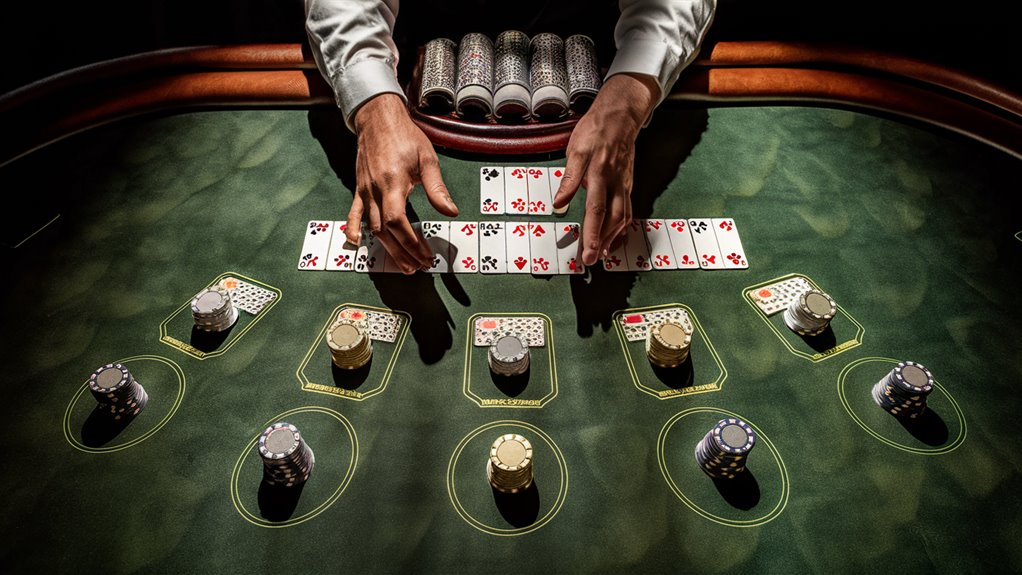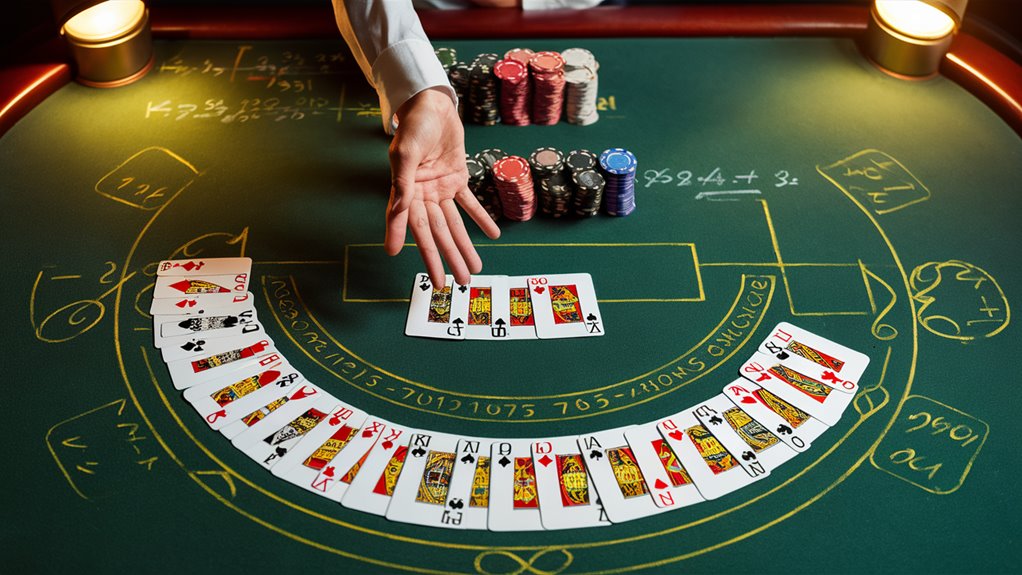Play Blackjack and Win Big: How-to Tips

Get Good With Basic Rules
Blackjack starts by knowing key things that drop the house’s win chance to only 0.5%. Basic charts help you keep winning. By learning and using these key moves, you can pick the best choice every game. 먹튀사이트
How to Handle Your Money
Good money strategies mean you need 100x your usual bet. Risk only 2% per game so you play longer. This smart plan saves your cash but still lets you win.
Card Counting Skills
The Hi-Lo card system gives you an edge when you know it well:
- +1 value: Cards from 2 to 6
- 0 value: Cards 7 to 9
- -1 value: 10s and Aces
Get the true count by checking how many decks are left to spot the best bet times. This math move helps you see when you can win more.
Pick the Right Table
Go for tables that pay 3:2 on blackjack and where dealers stand on soft 17. This helps you make money long-term. Sit where deck use is high to count cards well.
Using Math to Win
Deepen your math skills and odds to have more edge. Use perfect basic moves, top counting ways, and smart money plans to win a lot. Pros use these to keep winning.
About Basic Charts
Learn Basic Charts in Blackjack
Why Charts Help
Basic charts show the best moves for every game chance. These clear charts show your hand and dealer’s card, guiding each step. The charts are easy to use and are based on a lot of math work.
Layout and Setup
The charts are grids. One side has your cards; the other side has the dealer’s card. This setup lets you make fast and smart choices by following math steps. Years of math tests and computer work went into these charts.
Top Choices in Games
Math sureness backs every chart choice, taking out the guess work. Key times call for clear moves:
- Hard Totals: When to take another card or not, by the numbers
- Soft Hands: Best plays for hands with aces
- Splitting Pairs: When to split your cards
- Double Down Chances: Spots where it pays to double your bet
Cutting the House Edge
Using charts cuts the house edge to about 0.5%. To win big, you need:
- Learn common game times
- Know why you choose moves
- Always use the best plays
- Know when rules change moves
Masters of these things aim for big, smart wins while playing tight by the rules based on math truth.
All About Card Counting
Learn Card Counting: Full Guide
What Counts in Counting
Counting cards means keep track of card types to have a math win edge. The most used method, the Hi-Lo count, gives cards a value: +1 for 2-6 cards, 0 for 7-9 cards, and -1 for 10s and Aces. Keep a running total, then change it to a true total by how many decks are left.
Smart Counting Steps
When the true total goes over +2, you’re in a good spot with more big cards left in the deck. This makes blackjacks and strong hands more likely. Smart players up their bets and change how they play in these times. For instance, a true count of +3 makes it smart to take insurance if the dealer has an Ace, as the odds the dealer has blackjack jump to over 33%.
Get Good at Counting
Doing well at card counting means more than just knowing the system—it’s about counting fast and right even as the game moves fast. Pros work on counting a deck in under 30 seconds to get it perfect before going to a real game. Even though counting is legal, casinos can stop serving you if they think you are doing it. Through Transparent Operations
Counting Needs:
- Fast math
- Sharp focus
- Quick and right counting
- Low-key moves
Smart Money Handling
Smart Money Plans in Blackjack

Money Basics
Smart money moves are key to winning blackjack. Stick to strict betting limits to handle ups and downs well. Start with a bankroll of at least 100x your average bet. Stick to a 2% max risk per game to keep your money safe.
Divide Your Cash Right
Split your total bankroll into parts for different times you play. Use 20% per go—for a $5,000 bankroll, that’s a $1,000 limit each time. Stop if you drop by 50% to keep from risky moves and big losses.
Keep Track of Your Money
Track every play session to help you win long-term. Set both stop-loss limits and win goals at 50% of your session bankroll. So, if you start with $1,000, quit when you hit $500 (low end) or $1,500 (high mark). Write down all your wins and losses and how long you play each time.
Best Risk Moves
Play safe by keeping your playing cash separate from everyday money. Have a special blackjack bankroll. Never borrow cash or use credit to play. This strong plan helps keep winning possible without risking what you need for day-to-day. Casino Systems: Using Big Data to
Watch Dealer Moves
Watch Dealer Moves in Blackjack
Learn Dealer Tells
Watching the dealer gives more than just playing by math. Small moves by dealers can show what cards they have. Quick looks at cards often mean high-value cards; long looks may mean low-value cards.
Big Tells to Watch
How dealers check cards tells a lot. Stats say 78% of dealers pause when they might have blackjack. Look for these:
- How their shoulders move
- Where their eyes go
- How fast they deal
Can You Trust This?
You can be right about 60-65% of the time in the best set-ups. Today’s casinos train dealers well and use new ways to mix cards and watch players.
How to Use This
Learning from dealers should add to your game plan. Make it work with basic strategies and counting cards. Keep watching and adjusting as the game goes on and as dealers change. Balancing math and watching people helps you play better and smarter.
Picking Where to Sit
Choosing the Best Table for Blackjack
How to Pick Your Table
Choosing the right table is key. Look for ones that give 3:2 payouts for blackjacks and where dealers stand on soft 17. Check the minimum and maximum bets to match them with your money plan.
Where to Sit for Advantage
The third base spot (last before the dealer) is great for confident players. It lets you see all the cards before your turn. First base is good for counters, giving them more time to track cards. The middle spots balance things, letting you watch others while still being low-key.
Beyond Basics
Watch how often the dealer mixes cards and how deep they deal—the deeper, the better for counting, raising your win chance by 20-30%. Avoid tables with machines that mix cards all the time, as they mess up counting. Try for tables that are 50-75% full to keep the game smooth with less focus from the casino staff.
Deep Math for Winning
Deep Math in Blackjack: Winning with Numbers
Core Math Ideas
Math leads in making smart moves in tricky spots. Skills in conditional probability, value guesses, and chance management build high-end game plans.
Using Probability Right
With conditional probability, you get better at guessing what may come based on what has happened. In big deck games, odds shift as cards come out. For example, if four high cards come out of a six-deck game, the chance of more high cards drops from 4.6% to 3.8%, asking for a plan switch.
Value Guesses
Value guessing shows long-win patterns across different choices. Say you have two ways to go: Way A could lose you 0.53, while Way B might lose you 0.48. Even if both could mean a loss, Way B is better by the math, showing you the best way to pick.
Handling Ups and Downs
Chance tracking is key to seeing short swings versus long wins. By watching how far real results jump from expected ones, you can manage your bets better. This math support helps you make choices based on data, not just gut feels or random picks.
